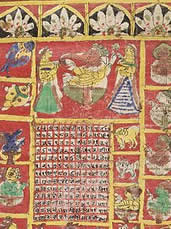Difference between Saka Samvat and Vikram Samvat
Key Difference: Saka Samvat and Vikram Samvat are two commonly used calendars in India. Saka Samvat has been adopted as an official civil calendar by India. Saka Samvat starts from 78 AD, whereas Vikram Samvat starts from 57 BC.
Samvat is a term that is used to refer to an era that is described through the Indian calendar. Thus, samvat as a term can be used to refer to any of the various hindu calendars. Shaka samvat and Vikram samvat are based on lunar months and solar years. However, the traditional shaka samvat follows the solar sidereal years, and the modern Shaka samvat follows the solar tropical years.
 Both are based on the Chaitra calendar years that are named after the solar months named as: - 1. Chaitra 2. Vaisakha 3. Jyaishtha 4. Ashadha 5. Sravana 6. Bhadra 7. Asvina 8. Kartika 9. Agrahayana or Margasirsha 10. Pausha 11. Magha 12. Phalguna
Both are based on the Chaitra calendar years that are named after the solar months named as: - 1. Chaitra 2. Vaisakha 3. Jyaishtha 4. Ashadha 5. Sravana 6. Bhadra 7. Asvina 8. Kartika 9. Agrahayana or Margasirsha 10. Pausha 11. Magha 12. Phalguna
Saka Samvat is believed to be based on the celebration that took place at the time of crowning Shalivahan king in the 78 AD. Gudi Padao (March-April) indicates the starting of this particular year. Reformulated Saka calendar is officially used in India as a civil calendar. Its year zero begins near the vernal equinox of the year 78 AD. Thus, by adding 78 to Saka year, we get Christian year. e.g. Saka 1752 + 89 = A.D. 1841. It is India’s National Civil Calendar and was accepted by Govt. of India on 22th March 1957. The year in this calendar starts on 1st of Chaitra, meaning 22th March in normal Gregorian calendar years, and on 21 March in a Leap Gregorian year. It is also used in Java and Bali with Hinduism religion in Indonesia.

Vikram Samvat is often associated with Raja Vikramaditya of Ujjain and it is believed that this calendar follows his victory over the Saka in 56 B.C. The New Year in this calendar begins with the first day of Kartik that follows Deewali, an Indian festival. In order to get a Gregorian date corresponding to the Vikram Samwat date, one needs to subtract 57 years from the Vikram Samvat date. For example: 2067 VS = (2089 – 57) AD = 2032AD. This is officially followed in Nepal and is also widely used in the West and North west part of India.
Some of the key differences are listed in the table below:-
|
|
Saka Samvat |
Vikram Smavat |
|
Epoch of the era with reference to the Gregorian Calendar |
AD year –78 from Mar/Apr to Dec AD year –79 from Jan to Mar/Apr |
AD year +57 from Mar/Apr to Dec AD year +56 from Jan to Mar/Apr (used in Chaitra calender) |
|
Based on |
crowning of Shalivahan king in 78AD. |
Believed to be based on the crowning of Vikramaditya of Ujjain in 56BC. |
|
Starting Mark |
Gudi Padvo (March - April) |
Diwali (Oct - Nov) |
|
Other names |
Shaka Samvat |
(Vikram Samwat, Vikram Sambt, Bikram Samvat, Bikram Samwat, Bikram Sambat or Vikram's Era |
|
Age |
Younger by 135 years |
Elder by 135 years |
Image Courtesy: en.wikipedia.org, pardaphash.com









Comments
Anonymous
Sat, 10/28/2017 - 22:56
Ramanathan
Thu, 08/17/2017 - 20:25
Rajan Pokhrel
Fri, 04/14/2017 - 16:24
discover vedic ...
Tue, 03/28/2017 - 08:38
Rajan Pokhrel
Fri, 04/14/2017 - 16:27
Sukhminder
Tue, 12/05/2017 - 11:44
Anonymous
Sat, 05/21/2016 - 01:15
Anonymous
Sun, 10/23/2016 - 17:00
NICE.........
DAGGU
Thu, 03/20/2014 - 13:14
not mentioned who is the ruler during that period and its importance .... better it shld be improved
shanku
Wed, 03/12/2014 - 11:44
Pages
Add new comment